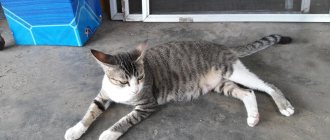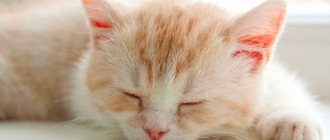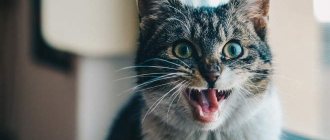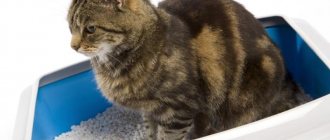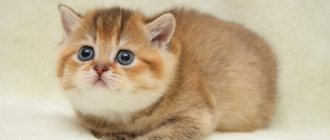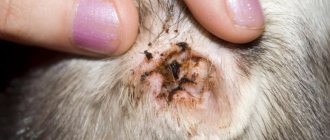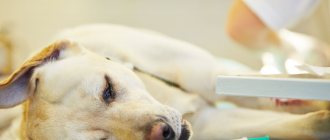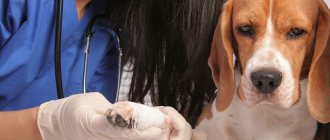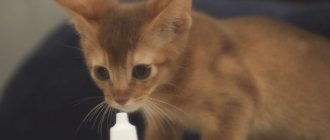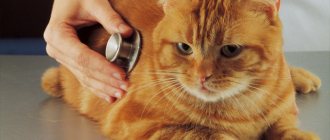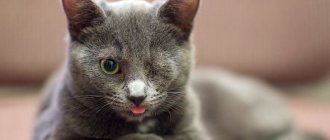- The main causes of poor appetite in cats
- If a cat doesn't eat well - reasons for sudden refusal to eat
- Viral infection as one of the reasons why a cat does not eat well
- Signal of a foreign body entering the digestive tract
- Inflammation of the stomach or intestines as one of the causes of poor appetite
- Poisoning as a reason why a cat eats poorly
- If your cat begins to eat little due to kidney failure
- Diseases of the teeth and oral cavity
- Pain syndrome and stress
- Emergency assistance before the veterinarian arrives
The main causes of poor appetite in cats
Cats by nature have a delicate internal organization. They are capricious and capricious, and unlike a dog, forcing it to do something against its will is very problematic. This also applies to food intake, for example, meaning dietary nutrition, which can be prescribed by a veterinarian as additional therapy for kidney failure, liver disease or disorders of the digestive system. Cats are picky creatures; they are capable of rejecting food offered by their owner that is not to their taste until they receive the coveted tasty morsel. But if there is a periodic refusal to eat and the owner notices that the cat eats very little, regardless of the food offered, you should be wary. This may be a sign of a systemic disease caused by a number of reasons that every cat owner should be aware of.
Nutrition for a nursing cat
The main requirement for a nursing cat's diet is that it be balanced and nutritious. The food should be rich in minerals, proteins, carbohydrates and amino acids necessary for milk production.
The frequency of feedings directly depends on the number of kittens in the litter. The main thing is that the cat should always have access to fresh food and water.
The frequency of feeding depends on the number of kittens
Dry food should be used only premium and higher class. You can try drying for pregnant cats or kittens.
Reference! To prevent your pet from getting stressed, it is better to simultaneously feed the food that she consumed previously.
A natural diet must include:
- lean meats and offal (beef, poultry, rabbit) with a net weight of at least 50% of the serving;
- low-carbohydrate supplements in the form of porridges that help normalize digestion;
- fiber in the form of greens, vegetables and fruits, as a supplier of minerals and vitamins, making it easier to cleanse the intestines of hairballs;
- a small portion of butter and yolk, which provide the cat’s body with fatty acids;
- Low-fat fermented milk products (cottage cheese, kefir, yogurt) should be given in separate portions.
Reference! A nursing cat should be given food at the first request, but leaving an uneaten portion for next time is not allowed. Stale foods can cause stomach upset, which will negatively affect the quantity and quality of milk produced.
If a cat loses its appetite, it is necessary to observe whether it is caused by a developing disease. It is best to immediately seek advice from a veterinarian if a problem arises.
Signal of a foreign body entering the digestive tract
Most owners often encounter this problem, which is especially typical for playful cats of long-haired breeds. These could be small fragments of toys, small bones, or simply large accumulations of fur from the animal itself. The main signs for identifying this factor are attacks of vomiting that occur when drinking water and food, abdominal pain and difficulty defecating. With prompt diagnosis and timely removal of the foreign material, the pet will recover completely.
Methods of treatment and prevention
Lack of appetite in a cat is not a diagnosis, but it can signal the presence of diseases dangerous to its health. Treatment in this case depends on the correct diagnosis. Often, a cat’s poor appetite is caused by reasons that have nothing to do with organ diseases and viral infections.
The main prevention of loss of appetite of an animal is proper care - timely vaccinations and examination by a veterinarian, compliance with the feeding regime.
Inflammation of the stomach or intestines as one of the causes of poor appetite
There are several factors that can contribute to the development of inflammation of the stomach and intestines in cats:
- Parasitic infestation is the entry into the body of an animal of larvae of worms and protozoa, the development of which gives impetus to refusal to eat food and its partial rejection through the occurrence of a gag reflex or diarrhea
- If a foreign body enters the gastrointestinal tract and causes injury to it
- For uremic gastritis, which occurs with chronic kidney disease in cats
- Taking unbalanced food
- Regular stressful situations
- Allergic reaction to food or its components
- Diseases of the liver and pancreas
The pathological state of the factors described above is accompanied by complete or partial refusal to eat. It is quite understandable why the cat began to eat little - constant vomiting and soreness in the abdominal area do not give her the opportunity to taste even her favorite food. Therefore, when the first signs of the disease appear, you should consult a veterinarian, and in the case of previously diagnosed gastritis, adhere to a strict diet.
Features of appetite during pregnancy
Reluctance to eat in pregnant cats may be due to:
- toxicosis;
- infectious disease;
- injury received;
- constipation;
- multiple births;
- polyhydramnios;
- death of the embryo.
Cat in the last week of pregnancy
In case of toxicosis, you can increase your cat's appetite by diversifying the menu and including vegetables and fruits in the diet. In recent weeks, as the size of the stomach decreases, it is necessary to switch to more high-calorie foods.
In all other cases, you need to immediately visit a veterinary clinic.
Poisoning as a reason why a cat eats poorly
Poisoning always takes place in an acute form, with a sharp refusal of the cat to eat and frequent bouts of vomiting, as well as other signs that are easy to distinguish upon visual inspection by the owner himself:
- Yellowness of visible skin appears
- Partial or complete absence of urination
- Convulsive contraction of the animal
- Arrhythmia and blue discoloration of visible skin
- Bloody discharge during vomiting and bowel movements
- Dyspnea
Confirmation of the diagnosis requires emergency intervention by a veterinarian and hospitalization of the pet in a veterinary clinic.
Loss of appetite due to viral infection
The disease knocks any living creature out of its normal routine - if a hyperactive cat suddenly loses interest in food and games, you need to show the animal to a veterinarian - an infection is possible.
The most common diseases are feline herpes and feline calcivirus. They do not pose a great danger to the animal, but require timely and competent treatment. Loss of appetite, nasal discharge, sneezing, red eyes and watery eyes are the main symptoms of these diseases.
Loss of appetite is a symptom of feline calcivirus
What to do if your cat does not eat during illness, you can ask your doctor directly. The answer will be clear: don’t force it, don’t force it from a syringe. These methods will give absolutely nothing. The cat will determine when it needs to eat - its appetite will return as the animal recovers.
If your cat begins to eat little due to kidney failure
There are two types of kidney failure in cats - acute and chronic, which are characterized by refusal to eat. There is severe emaciation of the animal, frequent vomiting and urination, as well as a constant feeling of thirst. A common cause of this condition may be poisoning from flowers of the lily family. The condition of acute renal failure can be treated with timely contact with an experienced veterinarian. Resuscitation facilities and prompt implementation of treatment procedures will help restore your pet’s health in the shortest possible time.
Signs of poor appetite
Have you noticed that your cat has lost her appetite, she has become lethargic and is increasingly refusing water? Of course, this attracts attention, especially if before, your pet ate twice as much. But this is definitely not a reason to sound the alarm and try to feed the animal by cunning. And there’s certainly no reason to run to a veterinary pharmacy to start emergency treatment of your cat at home. Remember: no self-medication!
First, you need to understand the reasons why your pet, once a lover of tasty treats, now began to ignore food? What to do if your cat has poor appetite and what could be the reasons?
Diseases of the teeth and oral cavity
A cat refuses to eat or eats very little - bad teeth or oral disease can be one of the common reasons for this behavior in animals. In this case, there is a complete or partial refusal to take favorite treats. The most common types of dental and oral diseases that can cause a pet to lose its appetite are:
- Excessive tartar deposits, which damage the gums, buccal mucosa and tongue, causing excessive salivation, chomping and painful sensations when chewing food. Putrid breath is the main sign of the disease;
- Poradontitis is inflammation of the gums and oral mucosa, which may precede the development of fistulas in the nasal cavity and orbit of the eyes;
- A viral infection that affects the oral mucosa, resulting in the formation of small ulcers that make it difficult to eat
Contacting a veterinary clinic will help to timely identify the initial stage of diseases through differential diagnosis and select the correct treatment for a full recovery.
Why does my appetite disappear?
There are actually many reasons. But there are three main categories: psychological, natural or health-related.
Problems of the first category can be solved by the owner independently and quickly:
- Dirty bowl. Cats are very clean animals and a dirty bowl or dried food with an unpleasant odor can ruin your pet’s appetite. But this is not the most dangerous thing, because a dirty bowl can cause the development of certain diseases in the animal.
- The need to eat from the same tray with other cats is similar in many ways to the first reason, but there is another point: cats are more independent creatures and not everyone is ready to share their food.
- Changing the feeding conditions (the bowl has been moved) also greatly affects the animal’s psyche; cats value stability very much and react painfully to any changes.
Reluctance to share food or disgust can cause a cat to refuse food
Reference
The norm for fasting while maintaining good health and activity for an adult is considered to be 2-5 days, for a kitten - 1 day.
Pain syndrome and stress
Sudden onset of pain associated with bruises, scratches and damage to internal organs, for example, when fighting with cats during mating festivities. There is aggression towards others, the pet is depressed, reluctant to make contact, and hides in the dark. After identifying the causes of pain, which can be easily determined by an experienced veterinarian, comprehensive treatment is prescribed until the pet recovers completely. Stress motivators indicating the reason why a cat eats little include:
- Change of residence of owners and transportation of the animal
- The appearance of a new pet in the apartment
- Changing the filler in the tray
- Switching to another food
- During the reproductive period
The true reason for the lack of appetite can be determined by a competent veterinary clinic specialist, who will find the root cause of the pet’s reaction and prescribe the appropriate procedures.
Diagnostics
The veterinarian should conduct a complete physical examination of the animal and listen to your history about the life history - what kind of food he receives, if you have several animals - how their relationships are, how often the cat bears and feeds kittens, what medications she receives and other symptoms, if any. Hyperthyroidism and diabetes are common causes in older and older cats and may be tested first.
To make a diagnosis, you will need to perform some tests, including:
- Biochemical profile, complete blood count and urinalysis to assess the cat's overall health and organs.
These tests can detect infection, kidney function, liver function, anemia, calcium, magnesium levels. All this data helps to create an overall picture of your health.
— Bile acid test
To assess the condition and function of the liver.
— X-ray or ultrasound of the abdominal cavity
To evaluate organs, look for tumors or aneurysms.
— Blood test to determine levels of T3 and T4 hormones.
Some cats with hyperthyroidism may have normal levels of these hormones in a blood test. If this is the case, a T3 suppression test (7 oral doses of T3 thyroid hormone and a blood test after the hormone has been given) may be performed. In a healthy cat, T4 levels will fall; in a cat with hyperthyroidism, T4 levels will remain the same or increase slightly.
— Fecal examinations
To search for helminths (parasitic worms).
Emergency assistance before the veterinarian arrives
At the first signs of refusal to eat, the main thing is not to panic and try to soberly approach the issue of determining the reasons:
- Eliminate the possibility of purchasing unsuitable food
- Try replacing food
- Call emergency veterinary help
- Do not start self-medication
- Test your cat's sense of smell while giving her warm food from your hand.
- Watch the cat, especially if you are in a suburban area - maybe the cat ate a mouse or ate from the neighbors
- Avoid pet overeating
Every owner of a cat must remember that neglect of a pet can affect the occurrence of poor appetite and the development of dangerous diseases. Contacting a veterinary clinic when the first symptoms of food refusal appear will help the veterinarian quickly make a final diagnosis and prescribe the most effective treatment. The health of your pets is in your hands, and attention and care will help prevent the appearance of the above-described signs associated with loss of appetite.
How much does a cat weigh?
The weight of cats depends primarily on the breed, and if a Mae Coon cat weighs about 7 kg, and a Siamese cat weighs only 3 kg, then this is normal.
Not only an experienced veterinarian can determine whether a cat is malnourished. And although the table below is arbitrary, every owner can use it to correlate the physical condition of your cat.
Signs your cat is underweight:
- The cat looks bony. The ribs on an underweight cat can be easily felt when you stroke its sides, and the spine can also be easily felt when you move your hand along its back.
- With significant weight loss, the hind legs appear bony.
- Rib narrowing is present in all cats, but is significant in malnourished cats.
- Obvious loss of muscle mass. Even thin breeds of cats should have developed muscles, especially the muscles of the upper/shoulder spine.
Intestinal obstruction
Complete stop or difficulty in moving processed food through the canal to the anus.
One of the main causes of pathology is considered to be blockage of the canal by some swallowed object. These can be threads, pins, needles, rags, toys, silica gel filler, Christmas tree rain and even hairballs.
This problem in cats is often caused by eating threads while playing.
The main symptoms are:
- decreased appetite or lack thereof;
- a sharp decrease in the number of bowel movements or absence of stool;
- intense, ever-increasing vomiting;
- pain and bloating in the abdominal area;
- lethargy, general malaise.
Reference! With intestinal obstruction, even drinking leads to another vomiting.
As a result of disruption of the body's functioning caused by such a pathology, dehydration quickly occurs. If left untreated for a long time, exhaustion occurs, body temperature drops, and shortness of breath appears. Failure to provide timely assistance can lead to the death of your pet.
Causes of weight loss
There are many possible reasons for weight loss. They are divided into acute (sudden), chronic (slow and progressive) and other reasons for which weight loss is a sign of a disease or conditions of detention.
Acute causes of weight loss:
- Acute kidney disease.
The result of decreased function of the organ responsible for removing toxins from the body.
Bacterial, protozoal and viral infections can lead to acute weight loss due to anorexia and/or vomiting and diarrhea.
Chronic causes of weight loss:
— C chronic kidney disease.
Kidney disease leads to decreased function of the organ, which provokes the formation of toxins in the body.
— Addison's disease (hypoadrenocorticism)
An endocrine disease in which chronic insufficiency of the adrenal cortex leads to a deficiency of hormones, especially cortisol.
An endocrine disease of the pancreas, which is responsible for the production of two hormones - insulin and glucagon, which regulate the level of glucose (sugar) in the blood.
- Exocrine pancreatic insufficiency.
A disorder caused by the pancreas not producing enough enzymes needed to digest complex food components such as proteins, triglycerides and complex carbohydrates, as well as large amounts of bicarbonates, which protect the lining of the organs from the effects of stomach acid.
— Feline immunodeficiency virus
A viral infection similar to HIV in humans.
Hyperthyroidism is almost always caused by a benign tumor of the thyroid gland that overproduces hormones. This is a common cause of weight loss in middle-aged and older cats.
Thickening of the wall of the left ventricle of the heart. This is a consequence of diseases such as hyperthyroidism or high blood pressure.
– Inflammatory bowel disease
Other reasons for weight loss:
— Cancer is a malignant tumor.
Cancer is more common in older and older cats and is a leading cause of weight loss.
Stomatitis, dental abscess, etc., which leads to reluctance to eat food and causes anorexia.
Insufficient caloric intake (malnutrition), which can be caused by food quality, not enough food, a dominant cat eating most of the food, etc.
— Infectious anemia of cats (hemobartonellosis)
The disease is caused by an unusual type of bacteria that attaches to the wall of red blood cells, destroying them in the process.
— Feline leukemia virus (FeLV)
A disease that is caused by a retrovirus that belongs to the same family as the feline immunodeficiency virus. Destroys the immune system and causes cancer.
Open ulcers develop in the folds of the stomach lining due to increased production of stomach acid, certain medications, parasites, stress, infection, and systemic disease.
A disease caused by inflammation of the nephrons in the kidneys.
— Heartworm
Parasitic worm infection of the heart and lungs. When a non-eartworm larva reaches a new host, it begins to grow and within a few months becomes an adult worm, living in the blood vessels leading from the heart to the lungs of the cat.
— Parasitic worms. Severe infestations of hookworms, roundworms, or tapeworms can lead to weight loss due to loss of nutrients.
How to calculate the required number of calories
REP - resting energy requirements (number of calories) a cat needs at rest for good metabolism is calculated using the formula.
30 cal x cat’s weight in kg +70 cal
- Cat weight 5 kg – 30 x 5 + 70 = 220 - this is the cat’s PEP
- Kitten weight 1 kg – 30 x 1 kg + 70 = 100 – this is the kitten’s PEP
- A cat with emaciation of 3.5 kg - 30 x 3.5 + 70 = 175 - this is the cat's PEP
- Overweight cat 6.5 kg – 30 x 6.5 + 70 = 265 – this is the cat’s PEP
EPE - the daily energy requirements required by your cat depend on age and condition, summarized in a table.
| Kittens | — | PEP x 2.5 |
| Adult healthy cat | — | PEP x 1.2 |
| Unneutered cat | — | PEP x 1.4 |
| Overweight cat | — | PEP x 1 |
| Obese cat | — | PEP x 0.8 |
| Malnourished cat | — | PEP x 1.8 |
Calculation of EPE
- Cat weight 5 kg - 220 x 1.2 = 264 cal.
- Kitten weight 1 kg – 100 x 2.5 = 225 cal.
- Malnourished cat 3.5 – 175 x 1.8 = 315 cal
- Obese cat 6.5 – 265 x 0.8 = 251 cal
Naturally, if a cat loses weight, its EPI drops, which requires a recalculation of its EPI. The same goes for kittens as their weight increases. Therefore, it is necessary to monitor your weight and calculate your EPE weekly.
Pregnant and lactating cats are allowed to eat as much as they want to be healthy. During this period of life they require additional calories.
Feed your cat good quality, high-calorie foods and weigh her once a week to help regulate her weight.
